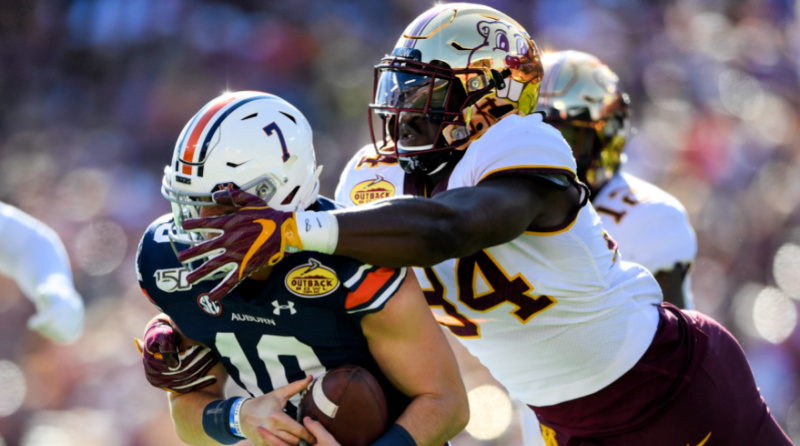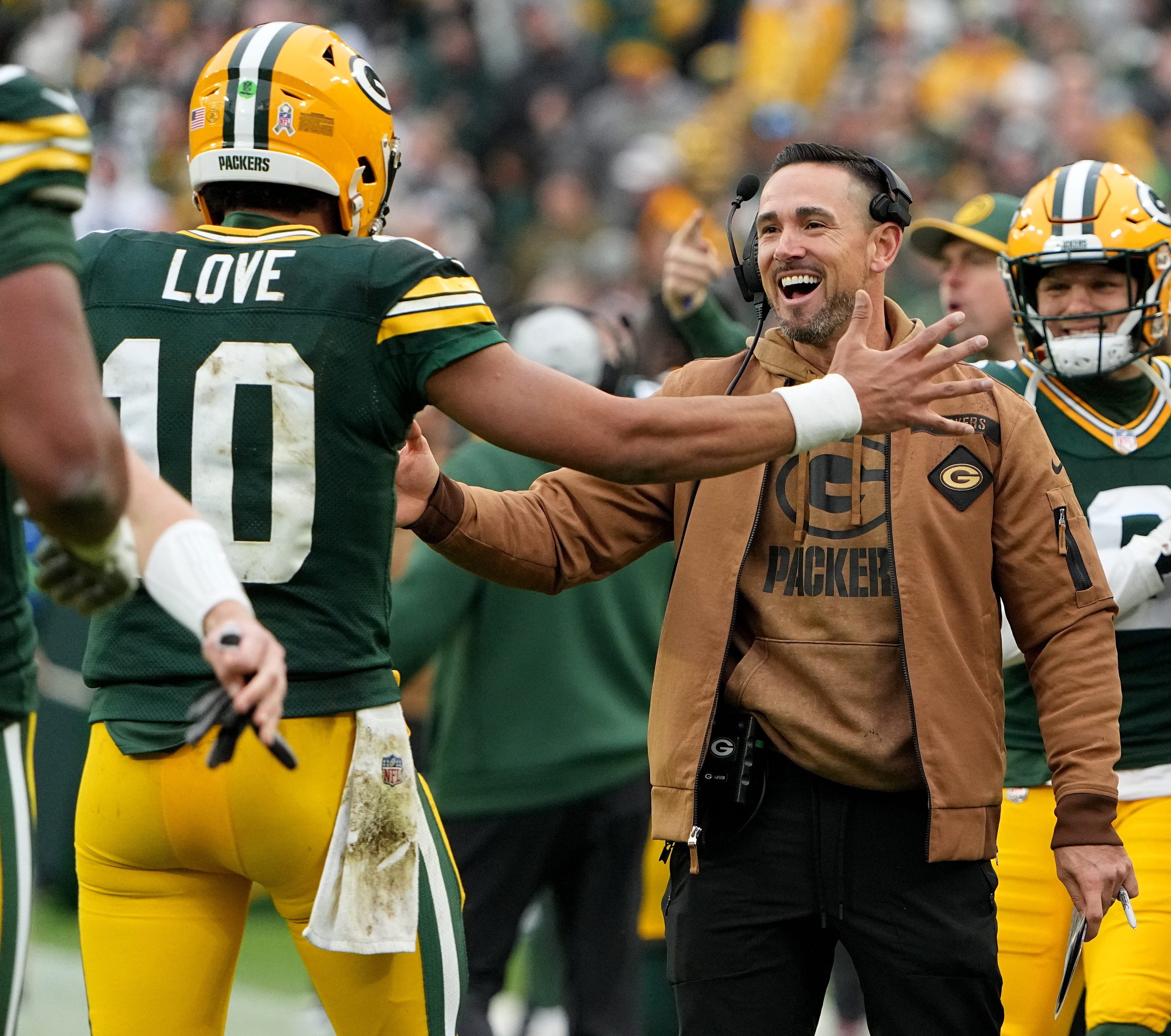Expert Analysis
4/13/22
7 min read
10 Future Franchise Players Who Will Be Drafted Outside Round 1

Year after year, the draft cycle focuses on projected first-round picks, many of whom end up disappointing. Going back only six years to the 2016 NFL Draft, a full six players drafted in the first round are already out of the league. That’s almost one out of every five players.
However, 2016 was also the draft that saw an entire starting lineup picked after the first round.
- QB: Dak Prescott
- RB: Derrick Henry
- WR: Michael Thomas, Tyler Boyd, Tyreek Hill
- TE: Tyler Higbee
- OL: Brandon Shell, Joe Thuney, Graham Glasgow, Cody Whitehair, Halapoulivaati Vaiti
- DL: Yannick Ngakoue, Chris Jones, Javon Hargrave, Emmanuel Ogbah
- LB: Myles Jack, Blake Martinez, Deion Jones
- CB: Xavien Howard, James Bradberry
- S: Kevin Byard, Justin Simmons
That’s easily a playoff team, even before talking about Kenyan Drake, Hunter Henry, Joe Schobert, and Jalen Mills on the bench.
So, who are some of the players from the 2022 NFL Draft that we could look back on in this regard?
RB Breece Hall, Iowa State & RB Kenneth Walker III, Michigan State
It almost feels like cheating to include two of the top running back prospects in the draft, but neither is likely to hear their name called on Day 1. Only eight RBs have gone in the first round over the past four years, but few have been overwhelming successes so far. Najee Harris, Josh Jacobs, and Saquon Barkley have had the best output so far, but even these three haven’t come close to the recent second-rounders Nick Chubb and Jonathan Taylor.
Hall is the most likely to sneak into the first round as the only college player to rush for over 3,000 yards since 2020. With outstanding instincts and patience, Hall is complemented by a ludicrous 40-inch broad and 4.39-second forty at 217 pounds. From a measurable standpoint, Hall compares favorably to 4-time Pro Bowler Ahman Green.
Walker is a different prospect entirely, as at 5-foot-9 he works with natural leverage and an incredibly tough attitude. With 4.38 speed, he nearly won the Heisman in 2021 by breaking a tackle on a third of rushing attempts and averaging 4.5 yards after contact. As a downhill runner with the speed to go the distance, Walker could be extremely successful in the right offense.
C Luke Fortner, Kentucky
Overlooked behind top IOL prospects Tyler Linderbaum, Kenyon Green, and Zion Johnson, Fortner could be extremely effective in a Zone scheme. With a 6-foot-4, 307-pound frame, he’s quick and fluid to the second level while showing the versatility to line up anywhere between the tackles. Despite turning 24 in May, Fortner is a plug-and-play Zone blocker who has the leadership (as a team captain), intelligence (completing two master’s degrees), and physical traits to lock down a starting role.
WR Christian Watson, North Dakota State
Christian Watson has Randy Moss-level potential. It’s outlandish, but it’s true. At 6-foot-4, 208 pounds, there are very few players who have ever been able to run a 4.36-second forty, leap 136 inches in the broad jump, and jump 38.5 inches vertically. RAS Metrics thinks the most comparable player by measurables is Calvin Johnson, even if Johnson has 30 pounds on him. Here’s their comparison of Moss to Watson.
It’s easy to get excited about the physical potential of a man who’s repeatedly hit 23 mph on GPS, the same as Tyreek Hill, or the man who led the country with 4.33 receiving yards per route run in 2021. For context, top draft options Garrett Wilson (3.00), Jameson Williams (3.12), and Drake London (3.52) weren’t close, and this also ignores NDSU’s tendency to line Watson up as a running back and let him knock out 7.6 yards per carry. Only six players have put together a season with a higher yards per route run since 2016 – a pair of Air Force receivers, Justyn Ross (2018), DeVonta Smith (2020), Michael Gallup (2016), and Tutu Atwell (2019). Three ran over 4.6, while the other three didn't crack 6-foot-1. This combination of production, efficiency, and measurables are historic.
However, Watson is still a work in progress. His ball skills lack consistency and there are some injuries in his background. With that said, Watson has the attitude and toughness to contribute as a blocking WR in year one and quietly develop into a superstar.
TE Trey McBride, Colorado State
As a tight end, McBride falls into the same bucket as the running backs listed earlier – there’s simply not many teams willing to draft a TE early. In the past five years, only five TEs have gone in the first round, but all of the league’s current top tight ends have been later selections. McBride is positioned to follow in their footsteps as a combo TE who can contribute as both a blocker and a receiver.
Despite being a bit undersized at 6-foot-3 and 246 pounds, his 4.56-second forty is phenomenal and he displays the toughness and strength to take on much bigger defenders. As a focal point of the Colorado State offense, McBride made highlight-reel catches to move the offense down the field. At the NFL level, he’ll be tough to take off the field.
DE Boye Mafe, Minnesota & DE David Ojabo, Michigan
Of every position, defensive end is potentially the most difficult to consistently find late-round production. An end needs to have the strength to contend with 360+ pound run-blocking behemoths while retaining the speed and flexibility to bend around the corner and catch the QB in the backfield. A pair of Big 10 stalwarts in Boye Mafe and David Ojabo will almost certainly be available on Day 2 but could develop into top-ten starters.
As two of the most physically-gifted prospects at the position, Mafe and Ojabo put up ridiculous numbers at the combine. From a 4.53- and 4.55-second forties to 35- and 38-inch verts, both clearly have the athleticism to succeed. The question marks come down to the other factors. At Minnesota, Mafe wasn’t frequently given full reign to rush the passer, while Ojabo’s Pro Day injury will sideline him for most of 2022. At a position that consistently needs superb athleticism, look for Mafe and Ojabo to bloom into productive NFL defenders.
LB Troy Andersen, Montana State
Speed, speed, speed. With every draft adding more athleticism into the league, defenses are forced to find their own athletes to compete. Fortunately, Troy Andersen has that in spades. At 6-foot-3 and 243 pounds he pulled off a 4.42-second forty and 128-inch broad jump, with an unconfirmed 3.99 shuttle – numbers that improve on prototype LB Luke Kuechly’s.
With a sub-11 100M dash in high school, Andersen was everything to his Montana State team. After a freshman campaign that won Big Sky Freshman of the Year at LB, he replaced an injured starter at QB and was named the conference’s best quarterback. Moving back to LB saw two more All-American seasons as well as a FCS DPOY nod. Although he’s got to develop his technique and add a bit of patience, would you bet against him?
CB Akayleb Evans, Missouri & DB J.T. Woods, Baylor
For each of the prospects listed so far in this piece who are oh-so-close to making it into the first round, Akayleb Evans and J.T. Woods are not. As much deeper prospects, they yet retain the athleticism and potential that have been hallmarks so far. Evans is an Ahkello Witherspoon-type who immediately stands out on tape for his penalties. As a player who can be excessively eager and grabby, the Tulsa transfer racked up his fair share of DPIs and holding calls, but an eagle-eyed scout will notice the length and explosiveness to potentially develop as a ball-hawking Cover 3 corner with press upside.
Woods similarly stands out negatively, with slow processing from centerfield and poor angles in space. As a developmental prospect, however, his upside is astounding. Baylor used Woods as a deep safety and slot corner but a move to the outside would both simplify his reads and create a comparison (by measurables) to Jalen Ramsey or even to Marshon Lattimore. Now, nobody is expecting Woods to play to their level, but the collegiate track athlete can break on the ball quickly and compete in the air. At the very least, a year on special teams could create an environment for Woods to develop into an above-average starter.








